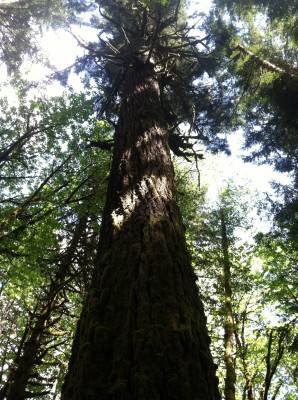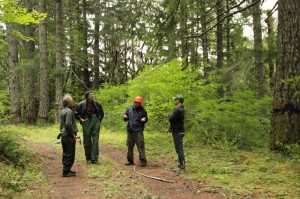By Rory Isbell, Cascadia Wildlands Legal Intern
More often than we prefer, those of us in the conservation world are at odds with our public lands agencies and managers. We want them to protect and restore the watersheds in which we live, and keep intact those that have evaded development or resource extraction. But the onward march of an economy rooted in natural resource extraction carries forth. Here in the Cascadia bioregion, the ghost of a century-old, scorched-earth timber economy still haunts those charged with managing our public lands, and has created an interesting dichotomy between the public agency and the conservationist. Former ruthless clearcutting has left our federal forests lands full of dense Douglas-fir plantations, fire-risks largely devoid of the imperiled older forest species. Variable density thinning can restore diversity back into these plantations, creating openings for hardwood species, and give the remaining trees ample room grow and mature. Such sales are regularly conducted commercially, and timber companies routinely make money in our federal forests off these sales. However, too much of a focus on making such thinning projects commercially inviting can lead to the thinning of older, native forests that would not benefit from thinning in order to allow the logging of bigger older trees. Or the sale could log too much, and leave too few trees so that the remaining trees simply blow over in the next big storm and we are left again with a clearcut. Like all things in life, management of these forests requires balance.
Over the last few years, Cascadia Wildlands has been forced to sue the Salem District of the Bureau of Land Management for irresponsible sales that were focused too heavily on the commercial aspect. One of the sales was a thinning sale, but was removing far too many trees in areas known to be occupied by imperiled mature forest species. After one win in court and one loss, it became clear to both the BLM and folks at Cascadia, that leaving the end game of these forests up to the whims of the courts was not working well for either party.
As a result, when the BLM announced the Rickreall Creek timber sale, Cascadia immediately noticed some significant problems with the sales, but also saw some room to allow the BLM to thin in the plantations involved in the project. So early in the project process Cacsadia staff and interns, along with the good folks at Oregon Wild and the Benton Forest Coalition began meeting with the Salem District BLM Field Manager for the Mary’s Peak Resource Area, Rich Hatfield. After numerous field visits to the various sales involved it was clear that there was room for middle ground with these sales, and clear that all parties wanted to avoid the expense and gamble of litigation.
As a legal intern at Cascadia Wildlands, I expected our interactions with the public lands agencies that often sell our forests to timber companies to be purely adversarial, so I was frankly surprised to see a public lands manager seeking a cooperative solution. Rich was genuinely interested in appeasing our concerns with the Rickreall Creek projects, and genuinely committed to altering the projects so as to prevent further legal liability on behalf of the BLM. After extensively touring the tree stands slated for harvest on two separate field visits, we developed a list of “asks.” We asked the BLM to forgo any unneeded thinning of mature and naturally biodiverse stands. We asked to enlarge a no-cut buffer surrounding a patch of snags crucial to late-successional habitat development. We asked to drop the building of new roads unnecessary to the goals of the project. We asked the BLM to conduct additional voluntary surveys for threatened red tree voles to ensure this imperiled species is not put at further risk. Cascadia Wildlands is happy to announce that a settlement agreement with the Salem District BLM that includes these changes to the Rickreall Creek projects was recently finalized.
As a legal intern at Cascadia Wildlands, I expected our interactions with the public lands agencies that often sell our forests to timber companies to be purely adversarial, so I was frankly surprised to see a public lands manager seeking a cooperative solution. Rich was genuinely interested in appeasing our concerns with the Rickreall Creek projects, and genuinely committed to altering the projects so as to prevent further legal liability on behalf of the BLM. After extensively touring the tree stands slated for harvest on two separate field visits, we developed a list of “asks.” We asked the BLM to forgo any unneeded thinning of mature and naturally biodiverse stands. We asked to enlarge a no-cut buffer surrounding a patch of snags crucial to late-successional habitat development. We asked to drop the building of new roads unnecessary to the goals of the project. We asked the BLM to conduct additional voluntary surveys for threatened red tree voles to ensure this imperiled species is not put at further risk. Cascadia Wildlands is happy to announce that a settlement agreement with the Salem District BLM that includes these changes to the Rickreall Creek projects was recently finalized.
The cooperative solution for Rickreall Creek highlights the power of the courtroom as the great equalizer. Through member supported litigation campaigns, we have inspired a culture change in our public lands agencies. When our public lands managers work with the public to find common ground and ensure their projects comply with the law, we all win. We can only hope that the BLM’s faithful execution of the law continues to be voluntary, and not by court order. After hard fought campaigns to enact the Endangered Species Act, the National Environmental Policy Act, the Northwest Forest Plan, and other pieces of legislation crucial to our environment, it is clear that our country has spoken to protect healthy and beautiful natural areas. Fulfilling the dream of our environmental legislation is much easier when our public lands managers seek the same goals.


